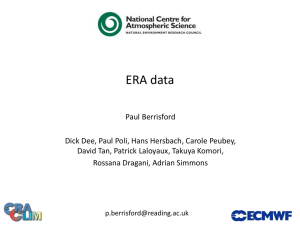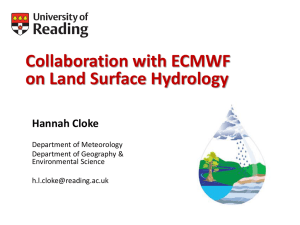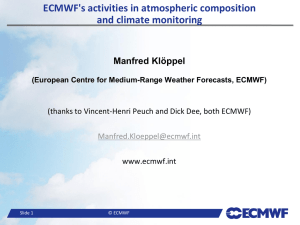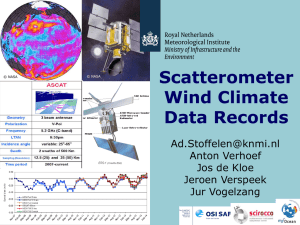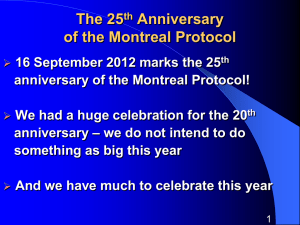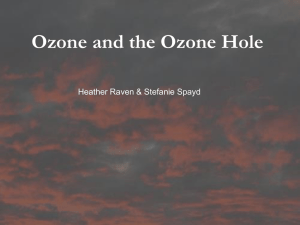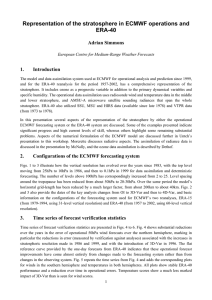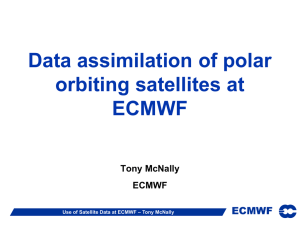and ERA-Interim
advertisement
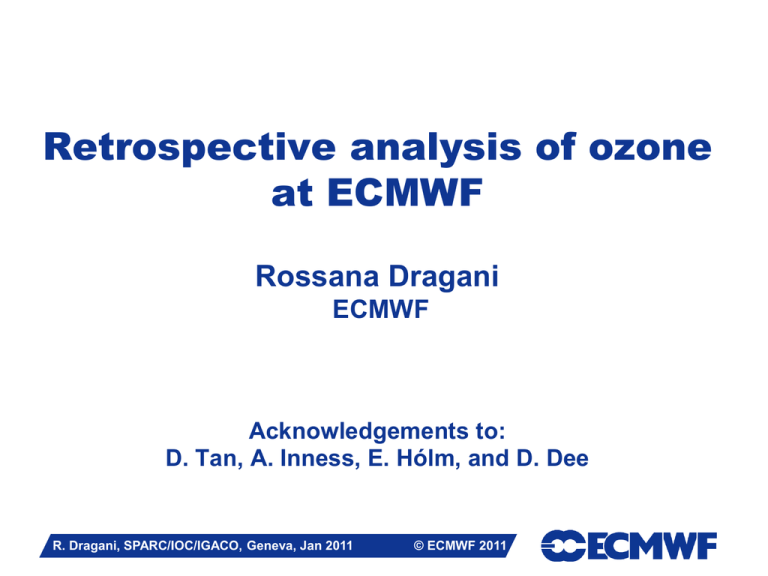
Retrospective analysis of ozone at ECMWF Rossana Dragani ECMWF Acknowledgements to: D. Tan, A. Inness, E. Hólm,Slide and 1 D. Dee R. Dragani, SPARC/IOC/IGACO, Geneva, Jan 2011 © ECMWF 2011 Overview Reanalysis activity at ECMWF Science application for reanalysis data Suitability to assess long-term variability Ozone analyses in ERA-40 and ERA-Interim Conclusions and remarks Slide 2 R. Dragani, SPARC/IOC/IGACO, Geneva, Jan 2011 © ECMWF 2011 Reanalysis at ECMWF: Reanalysis is based on analysis methods developed to provide initial states for numerical weather prediction. It applies a fixed, modern data assimilation system to multi-year sets of observations of different types, resulting in more uniform analysis quality. ERA-15: ERA-40: ERA-Interim: 1979 – 1993 1957 – mid-2002 1989 onwards ORA-S3: MACC: 1959 onwards 2003 – 2010 ERA-CLIM: European Reanalysis of Global Climate Observations An EU project to help prepare the next ECMWF Slide 3 reanalysis ERA-20C: 1900 onwards R. Dragani, SPARC/IOC/IGACO, Geneva, Jan 2011 © ECMWF 2011 The ERA data base: www.ecmwf.int Slide 4 ERA-Interim reanalysis is continuing in near real-time Products are updated monthly R. Dragani, SPARC/IOC/IGACO, Geneva, Jan 2011 © ECMWF 2011 Science applications that rely on reanalysis data “Observations” for verification and diagnosis - Development of forecast model, climate model; calibration of seasonal forecasting systems; use of data assimilation increments for identifying model errors Input data for model applications - for smaller-scales (globalregional; regionallocal), ocean circulation, chemical transport, … Study of short-term atmospheric processes and influences - Polar vortex dynamics,… Providing climatologies Assessment of the observing system - providing feedback on observational quality, bias corrections and a basis for homogenization studies; contributing to data reprocessing activities Slide 5 Study of long-term climate variability and trends R. Dragani, SPARC/IOC/IGACO, Geneva, Jan 2011 © ECMWF 2011 Suitability to assess long-term changes: ERA-40 + ERA-Interim Mid 1957 to the present Analyses are physically coherent and consistent with observations A realistic model can propagate information in poorly observed areas as well as moved forward in time. MIPAS O3 retrievals: 23 Sep 2002 Ozone fc: D+6 from 17 Sep 2002 © ESA, 2002. Ozone analysis: 12Z 23 Sep 2002 Slide 6 Geer, Planet Earth Autumn 2004, www.nerc.ac.uk R. Dragani, SPARC/IOC/IGACO, Geneva, Jan 2011 © ECMWF 2011 Suitability to assess long-term changes: From archived weather analyses: From a retrospective analysis: Reanalysis uses a modern, stable and invariant forecasting /assimilation system to reprocess (re-analyse) past observations: Remove artificial changes introduced by model upgrades Changes in the observing system and their error characteristics can also produce shifts and spurious trends. Slide 7 - ERA-Interim used VarBC for all radiances - ERA-Clim will also use VarBC for all L2 products (O3, WV) R. Dragani, SPARC/IOC/IGACO, Geneva, Jan 2011 © ECMWF 2011 Ozone reanalyses at ECMWF: Ozone has been reanalysed in ERA-40 and ERA-Interim - MACC also reanalysed ozone for the period 2003-2010. Long record: ERA-40 until Dec 1988 + ERA-Interim from Jan 1989. Main differences between ERA-40 (Cy23r4) and ERA-Interim (Cy31r2): - Assimilation scheme: ERA-40 used 3D-Var; ERA-Interim used 4D-Var - Data usage - ERA-Interim ERA-40 for radiances Variarional Bias Correction (VarBC) - Upgrades in the ozone model d O3 dt c0 c1 O3 O3 c2 T T c3 O3 O3 c4 Cl EQ O3 2 - Horizontal resolution: T159 (125km, ERA-40) T255 (80 km, ERA-Interim) ERA-40 ozone analyses validated by Dethof Slide 8and Hólm (2004, QJ). ERA-Interim ozone analyses validated by Dragani (2011, QJ submitted). R. Dragani, SPARC/IOC/IGACO, Geneva, Jan 2011 © ECMWF 2011 Ozone in ERA-40: Hilo (1992-1995) JFM JJA Dethof & Hólm (2004) Sonde ERA-40 Neumayer (1992-1995) Hohenpeissenberg (1983-1987) JFM JJA Slide 9 R. Dragani, SPARC/IOC/IGACO, Geneva, Jan 2011 © ECMWF 2011 SO Ozone in ERA-Interim: TCO validated against OMI TCO (TOMS-like); TCO from Dobson Spectrometers (WOUDC); TCO climatology created as a 5-year running mean from the NASA merged satellite. 3D O3 analyses (Jan 89-Dec 08) validated against WOUDC sondes; Satellite data. V6.2 SAGE: MLS: V5 HALOE: POAM: R. Dragani, SPARC/IOC/IGACO, Geneva, Jan 2011 V2.2 V19 Slide 10 V6 V4 © ECMWF 2011 Validation of the 3D O3 reanalyses: Sat-An Sat Matching criteria: Dt 30 hPa 3 hrs. ERA-Interim analyses were interpolated at the obs locations. GOME SAGE HALOE MLS POAM R. Dragani, SPARC/IOC/IGACO, Geneva, Jan 2011 Slide 11 © ECMWF 2011 Summary of the comparisons: 1989-2008 Lat 30 - 90 N 30S - 30N 30 - 90 S Lev (hPa) SAGE HALOE MLS POAM 5 ±5% [0,+5]% [0,+5]% [-25,+5]% 10 [-10,+5]% [-5,+1]% [-5,+3]% [-25,+10]% 30 [0,+20]% [-2,+20]% [0,+20]% [-10,+20]% 65 [-20,+10]% [-2,+10]% [-20,+10]% [-20,+10]% 5 ±5% ±5% ±5% 10 ±10% ±5% [-5,+8]% 30 [0,+20]% [0,+20]% [0,+20]% 65 [-20,+30]% [-5,+20]% [+5,+25]% 5 [-8,+5]% ±2% [-8,+5]% [-40,+1]% 10 [-10,+5]% [-8,+1]% [-10,+3]% [-40,-5]% 30 [0,+20]% 65 [-20,+20]% R. Dragani, SPARC/IOC/IGACO, Geneva, Jan 2011 Slide 12 [0,+20]% [0,+20]% [-20,+10]% [-2,+20]% [-20,+20]% © ECMWF 2011 [0,+20]% ERA-40 vs. ERA-Interim: Jan 1989 - Aug 2002 UARS MLS 30-90 S 30 S-30 N 30-90 N HALOE RMSO Slide 13 SAT 3 RMS O ERA Interim 3 O R. Dragani, SPARC/IOC/IGACO, Geneva, Jan 2011 SAT 3 © ECMWF 2011 ERA40 3 O ERA-40 vs. ERA-Interim: Comparisons with ozone sondes 203 soundings 942 soundings 227 soundings 238 soundings 30N – 30S Jan-Feb-Mar 60 – 90 S Sep-Oct ERA-Interim ERA-40 Pre-GOME (1989-1995) R. Dragani, SPARC/IOC/IGACO, Geneva, Jan 2011 Slide 14 © ECMWF 2011 GOME (1996-2001) Conclusions ERA-40 O3 analyses showed general good agreement with observations, but some problems were seen e.g. at mid-latitudes in winter, and at high latitudes in the SH in spring. ERA-Interim O3 analyses compare well with observations, and show departures from SAGE, MLS and HALOE ≤10% in the middle stratosphere, and ≤ 20% in the lower stratosphere. ERA-Interim better than ERA-40 in the UTLS region before 1996, and over the whole stratosphere afterwards (GOME assimilation). Planned improvements on ozone: - Use the Variational Bias Correction (VarBC) scheme with L2 data. - Revise/improve the assimilation of ozone profiles (e.g. SBUV data) - Assimilate ozone information from different Slide 15data type/instruments (ozone-sensitive radiances, L2 ozone data not yet used, e.g. those used for validation). R. Dragani, SPARC/IOC/IGACO, Geneva, Jan 2011 © ECMWF 2011 Remarks: What can reanalysis deliver? - Consistent with observations - Physically coherent - Complete, with no gaps - Comprehensive - Accurate variability and trends - Meaningful information about uncertainties Progress towards climate quality requires open access to all input data. Slide 16 Progress is iterative and needs regular re-processing. R. Dragani, SPARC/IOC/IGACO, Geneva, Jan 2011 © ECMWF 2011
